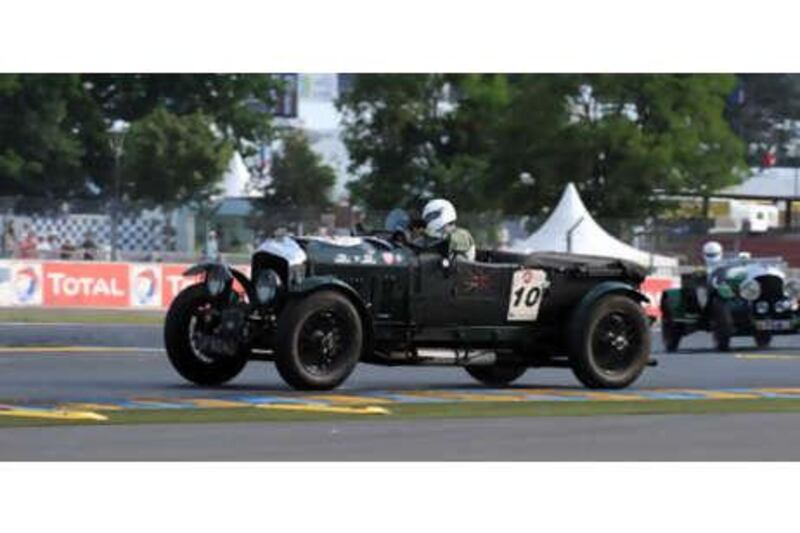Lovers of old cars might have regarded last weekend's Le Mans Classic as a dream, but for your correspondent it briefly became a nightmare. Have you ever experienced an anxiety dream where you're supposed to be somewhere important, but never seem to arrive? Well, dreams can come true, as I discovered when trying to link up with Martin Overington, a businessman from south-east England, who'd brought his 1929 supercharged 4.5 litre "Blower" Bentley for some serious racing, on the track which annually still plays host to the modern 24-hour race.
Le Mans is prone to gridlock every two years when thousands of car enthusiasts descend on it to watch people tearing around in often seriously exotic old machinery. Naturally, many drive there, often in classics that suffer in traffic jams, particularly when it's hotter than a sauna, and in the hour and a quarter I spent trundling in a bumper-to-bumper crawl, I passed an increasing number of moribund Jaguars, Alfas, etc, with owners tending to them like paramedics helping elderly heat-stroke victims.
Abandoning my car, I trudged to the sprawling race venue, which comprises a twisting circuit, partially made up of commandeered public roads, but with a series of enormous grandstands at its heart, surrounded by tents and stalls selling everything from floppy pizzas to car-themed memorabilia. Thousands of visitors milled around like overheated army ants, or were ordered about by stressed, perspiring marshals.
Overington had told me approximately where he was, reckoning this was about 15 minutes away, but naturally I became lost, and requests to the marshals for directions resulted in hunted looks and vague finger pointing. With Overington's mobile diverting to answerphone, the next hour and a half was a stressful route march, before I found him completely by chance. Fortunately, he was un-irritated and talked cheerfully about a hobby that would terrify the life out of many people and their bank managers. He wouldn't say how much the Bentley is worth, but in some parts of Europe you could buy a house for less. It's also "interesting" to drive at speeds exceeding 120mph, which Overington does when he's racing.
"It's like a lorry," he said. "Brakes? It hasn't got any. I use the gears to slow down and the lights are appalling. At night I find myself looking over the screen and trying to guess where the corners are." The car itself is massive. WO Bentley trained as a railway engineer, and his designs have the presence of steam locomotives, but at a time when over-engineered components tended to break less frequently, might was definitely right.
It certainly paid off at Le Mans, where between 1926 and 1930, Bentley's cars proved unbeatable. Overington also owns a similarly period Type 35B Bugatti, which is dragonfly delicate, and about as robust. By contrast, the blood and thunder Bentley has always got him home, and is regularly used for European holidays. He thinks people who drive these cars in anger in a modern world where there are seatbelts, airbags and steering columns that don't spear their chests in an accident, are "madder" than the men who piloted them when new.
He knew "it was going to hurt", when his Bugatti hit a tyre wall; "and I wasn't wrong", but car and driver were racing again within three days. "You just get on with it," says Overington, who clearly loves every minute. Le Mans Classic races run all day and overnight, with cars from different periods competing against each other in relays lasting about an hour. Racing for the oldest wheeled competitors begins with an "ears of corn" start, with cars parked at 45 degrees from the pits and drivers running to them.
Overington's Bentley was set to compete at 10pm then a bleary 5.30am start with a final blast the following afternoon. It was one of a field of 64 cars dating from between 1923 and 1938 that, he pointed out, represents a period of huge technical leaps forward, giving newer machinery a big advantage. The Bentley added another challenge by pumping oil over its driver's feet, which made working the pedals a slippery experience. "I was wiping my shoes on my trousers," said its owner.
Despite this distraction, by the third bakingly hot race, the car thundered home in ninth place, and was ranked 10th overall for the three events, something Martin Overington reckoned was "a bloody miracle". Overington thinks "too much money" can spoil events of this sort. He reckons people like him should see themselves as custodians rather than owners of their cars and not view them as status symbols.
He remembers as a teenager being stung by a Blower Bentley owner telling him "not to touch something you'll never be able to afford". "We should respect the paying public," he said. "If it wasn't for them, we wouldn't be doing this." motoring@thenational.ae











